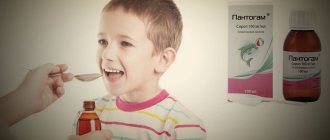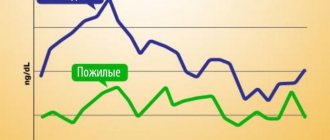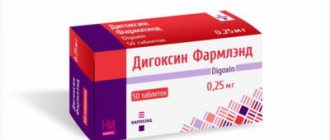Write a review
Reviews: 0
Manufacturers: TsNKB FSUE (Russia), PIK-PHARMA PRO LLC (Russia)
Active ingredients
- Not indicated. See instructions
Disease class
- Schizophrenia
- Neurotic disorder, unspecified
- Mental retardation, unspecified
- Specific developmental disorders of speech and language
- Specific developmental disorders of learning skills
- Specific developmental disorders of motor function
- Impaired activity and attention
- Tics unspecified
- Enuresis of inorganic nature
- Stuttering [stammering]
- Huntington's disease
- Parkinson's disease
- Other extrapyramidal and movement disorders
- Myoclonus
- Extrapyramidal and movement disorder, unspecified
- Epilepsy, unspecified
- Vascular cerebrovascular syndromes in cerebrovascular diseases (I60-I67*)
- Cerebral palsy
- Cerebral atherosclerosis
- Cerebrovascular disease, unspecified
- Brain disorder in newborn, unspecified
- Excessive activity
- Consequences of intracranial injury
- Antipsychotic and neuroleptic drugs
- Other types of malnutrition
- Neurogenic bladder weakness, not elsewhere classified
Clinical and pharmacological group
- Not indicated. See instructions
Pharmacological action
- Nootropic
- Anticonvulsant
Pharmacological group
- Nootropics
Analogues of the drug according to ATC codes:
VINPOTROPIL GLYCINE CALCIUM HOPANTHENATE COGITUM COMBITROPIL CORTEXIN CORTEXIN MINISEM NOOCLERIN NOOPEPT OMARON PANTOGAM PANTOGAM PANTOCALCIN PIRACESIN PIRACETAM + CINNARIZIN SEMAX PHESAM PHENOTROPIL CEREBROLYSATE CEREBRUS CEREBROLYSIN OLYSATE CYTOFLAVIN All
Interaction with other pharmaceuticals
When prescribing Pantogam active, you should remember that the medicine:
- Extends the effect of barbiturates on the body.
- Strengthens the anticonvulsant effect of medications taken.
- Prevents the development of adverse reactions during treatment with Neuroleptics, Carbamazepine, Phenobarbital.
- Potentiates the therapeutic effect of local anesthetics (procaine).
When used simultaneously with etidronic acid and glycine, the effect of taking the drug is enhanced.
Release form, composition and packaging
Hard gelatin capsules, size No. 1, yellow; the contents of the capsules are white or white powder with a yellowish tint.
| 1 caps. | |
| D,L-hopantenic acid | 200 mg |
Excipients: microcrystalline cellulose - 13.98 mg, magnesium stearate - 1.02 mg.
Composition of the capsule shell: gelatin, glycerol (glycerin), nipagin (methyl parahydroxybenzoate), nipazole (propyl parahydroxybenzoate), sodium lauryl sulfate, purified water, titanium dioxide, yellow iron oxide.
10 pieces. — contour cell packaging (6) — cardboard packs. 15 pcs. — contour cell packaging (4) — cardboard packs. 60 pcs. — polymer jars (1) — cardboard packs.
Hard gelatin capsules, size No. 0, white; the contents of the capsules are white or white powder with a yellowish tint.
| 1 caps. | |
| D,L-hopantenic acid | 300 mg |
Excipients: microcrystalline cellulose - 20.97 mg, magnesium stearate - 1.53 mg.
Capsule shell composition: gelatin, glycerol (glycerin), nipagin (methyl parahydroxybenzoate), nipazole (propyl parahydroxybenzoate), sodium lauryl sulfate, purified water, titanium dioxide.
10 pieces. — contour cell packaging (3) — cardboard packs. 10 pcs. — contour cell packaging (6) — cardboard packs. 15 pcs. — contour cell packaging (2) — cardboard packs. 15 pcs. — contour cell packaging (4) — cardboard packs. 30 pcs. — polymer cans (1) — cardboard packs. 50 pcs. — polymer jars (1) — cardboard packs.
Instructions for use and dosage (adults, elderly, during pregnancy and lactation, children)
Pantogam Active is taken orally a third of an hour after eating breakfast and lunch twice a day. It is preferable to use in the morning and before bed. Take 1-4 capsules 200 mg. The maximum daily dosage is 12 capsules.
Take 300 mg capsules up to three times a day. The maximum number of capsules per day is 8 pieces. The duration of therapy is from one month to four. Sometimes the course can be extended to six months or even a year. After 3 months, you can do another course of treatment.
Pantogam Active is prohibited for use in children under 18 years of age. It is also prohibited to take during pregnancy and lactation. Or stop breastfeeding for the duration of treatment.
Approved for use in older age groups. The dosage is the same as for adults.
pharmachologic effect
The action of Pantogam active is associated with the presence of gamma-aminobutyric acid in its structure, which directly affects the GABAB receptor-channel complex. Pantogam active is a racemic mixture of equal amounts of the R-form of hopantenic acid and its S-isomer. The presence of the isomer improves the transport and interaction of the drug with the GABA receptor. Pantogam active has a more pronounced nootropic and anticonvulsant effect than first-generation hopantenic acid preparations.
Pantogam active increases the brain's resistance to hypoxia and the effects of toxic substances, stimulates anabolic processes in neurons, and combines a moderate sedative effect with a mild stimulating effect. It has antiasthenic and mild anti-anxiety effects. Reduces motor excitability, streamlines behavior. Activates mental activity and performance. Causes inhibition of the pathologically increased bladder reflex and detrusor tone.
Side effects
The use of Pantogam syrup, as well as tablets, is often accompanied by unwanted reactions. If they occur, you should stop taking the drug and visit the doctor who prescribed it. The side effects listed below are ranked according to frequency of occurrence, ranging from very common to very rare:
- The immune system. Various allergic manifestations: skin rashes like urticaria, inflammation of the nasal mucosa, accompanied by swelling, congestion, serous secretion, conjunctivitis.
- Mental disorders. Sleep disorders, in isolated cases drowsiness is observed.
- CNS. Headache, noise or buzzing in the head, dizziness.
- Digestive system. Nausea, pain in the upper abdomen.
It is worth noting that undesirable effects may not appear immediately; their occurrence depends on the individual characteristics of the body.
Indications
- cognitive impairment in organic brain lesions (incl.
- consequences of neuroinfections and traumatic brain injuries) and neurotic disorders;
- cerebrovascular insufficiency,
- caused by atherosclerotic changes in cerebral vessels;
- extrapyramidal hyperkinesis (myoclonus-epilepsy,
- Huntington's chorea,
- hepatolenticular degeneration,
- Parkinson's disease and others),
- as well as for the treatment of extrapyramidal syndrome,
- caused by taking antipsychotics;
- for epilepsy together with anticonvulsants;
- psycho-emotional overload,
- decreased mental and physical performance,
- to improve concentration and memory;
- neurogenic urinary disorders (pollakiuria,
- imperative urges,
- urge urinary incontinence,
- enuresis);
- for schizophrenia in complex therapy.
Pantogam asset
Active substance:
D,L-hopantenic acid
Pharmgroup:
Nootropics
Average price in pharmacies
| Name | Manufacturer | average price |
| Pantogam 0.1/ml 100ml syrup | PIK-PHARMA | 439.00 |
| Pantogam 0.25 n50 tab | PIK-PHARMA | 423.00 |
| Pantogam 0.5 n50 tab | PIK-PHARMA | 666.00 |
| Pantogam active 0.3 n60 caps | PIK-PHARMA | 523.00 |
Analogs for the active substance:No data on synonyms | Application area:Wilson-Westphal-Konovalov disease Wilson-Konovalov disease Wilson's disease Wilson-Konovalov syndrome Impact of stress factors Impact of extreme situations Secondary disorders of mnestic functions Secondary neurotic symptom Huntington's disease (chorea) Hepatolenticular degeneration Hepatocerebral dystrophy Rheumatic hyperkinesis Choric hyperkinesis Hyperkinesis of central origin Hyperkinesis Brain hypoxia Yuppie flu Diabetic asthenia Hepatocerebral dystrophy Encephalopathy Prolonged emotional stress Daytime enuresis Other neurotic conditions Diseases of the brain of a vascular and age-related nature Forgetfulness Urinary retention Difficulty concentrating Difficulty in mental functioning Difficulty urinating Obstructed urine flow Idiopathic bladder instability Intellectual disability Intellectual-mnestic disorder Intellectual-mnestic disorder Mental infantilism Exhaustion of the nervous system Physical exhaustion Cognitive impairment Coma due to cerebrovascular accident Correction of side effects of neuroleptics Correction of side effects of neuroleptics Lacunar status Congenital copper toxicosis Menkes disease Metabolic and vascular disorders of the brain Memory impairment Intellectual impairment Impaired blood supply to the brain Violation of mnestic functions Cerebrovascular accident Urinary dysfunction Urinary dysfunction Violation of mental activity Thinking disorder Impaired bladder emptying Disturbance of urine outflow Memory impairment Impaired mental performance Brain dysfunction Dysfunction of the cerebral cortex Cerebral circulation disorders Impaired thinking function Thinking disorders Memory disorders Neurosis Neurosis with increased irritability Neuroses Neuroses of all kinds Neuroses with retardation Neuroses of the heart Neurotic disorders in alcoholism Neurotic disorders with retardation Neurotic disorders with anxiety syndrome Neurotic reactions Neurotic symptoms in alcoholism Neurotic conditions Neurotic syndrome Neurotic disorder Urinary incontinence Malaise Cerebrovascular insufficiency Neuroleptic extrapyramidal syndrome Neuropsychic stress Nervous exhaustion with depression Nocturia Nocturnal polyuria Nocturnal pollakiuria General mental fatigue General weakness General physical fatigue General malaise Weakening intellectual productivity Memory loss Residual effects of traumatic brain injury Acute intoxication with antipsychotic drugs Acute cerebrovascular insufficiency Acute polyuria Acute cerebrovascular accident Mental retardation Memory decline Parkinsonism of vascular origin Pathological fatigue Primary disorders of mnestic functions Side effects of neuroleptics Increased fatigue Increased fatigue Pollakiuria Pollakiuria and nocturia |



